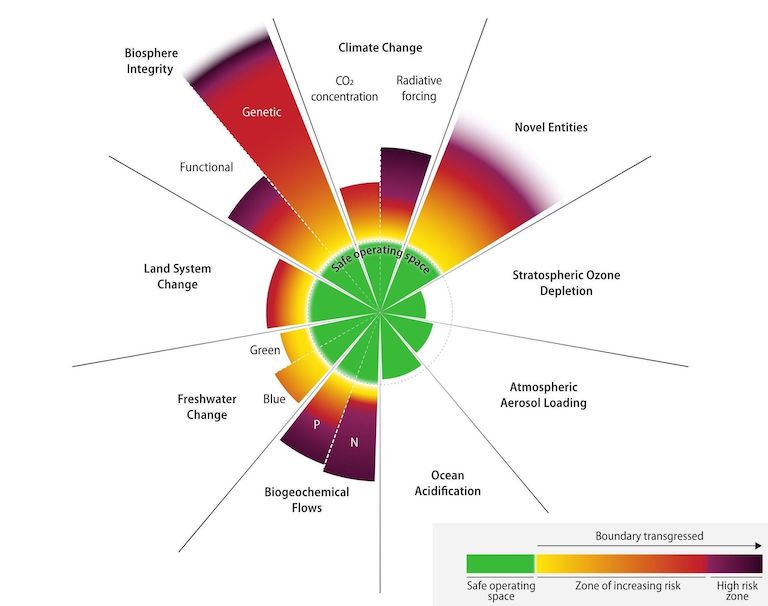- The planetary boundaries theory—the concept that the Earth has an operating system that is being destabilized by humanity, which is endangering the planet’s habitability—has been updated in a new study published in Science Advances.
- The updated framework now provides clear thresholds for each of the nine planetary boundaries, including three whose thresholds were previously unquantified: the boundaries for novel entities (various forms of pollution), atmospheric aerosol loading, and the biosphere.
- These nine quantified boundaries act like guardrails beyond which humanity cannot push without causing great risk to Earth’s operating systems and life as we know it.
- The authors report that six of the nine boundaries have already been breached and call the updated framework a “wake-up call” to humanity. But they also suggest that if action is taken promptly, things can be done to bring Earth’s life support system back into balance.
A new study has found that human activities are pushing Earth ever closer to its planetary limits—threatening to destabilize Earth’s safe operating space, and triggering a “wake-up call” to humanity that we are fast leaving behind the Holocene, a relatively stable epoch that has supported human life over the last roughly 10,000 years and allowed for the rise of civilization.
Published in Science Advances, the paper provides an update to the planetary boundary framework, a theory that suggests Earth’s life support system consists of nine key elements—each possessing a “boundary,” or limit. So long as each of these system elements stays within its boundary, the world operates in relative balance, supporting life as we know it and allowing humanity to thrive.
However, the theory says, human activities are rapidly pressing past those boundaries, putting Earth’s safe operating space at high risk.
In the new paper, the nine boundaries are defined as climate change, change in biosphere integrity, stratospheric ozone depletion, ocean acidification, biogeochemical flows including phosphate and nitrogen cycles, land system change, freshwater change, atmospheric aerosol loading and novel entities (human-caused pollution from microplastics, synthetics chemicals, radioactivity and more).

In 2009, a team of international researchers first proposed the planetary boundaries framework in a paper published in Nature—in 2015, many of the same authors published a revised version of the theory. However, these earlier versions had many knowledge gaps. At the time, for instance, the quantitative boundaries for novel entities, atmospheric aerosol loading and the functional integrity portion of the biosphere boundary remained undefined.
The updated framework now provides quantified boundaries for each of the nine Earth systems. The novel entities boundary, for example, uses a finding from a 2022 paper to define its threshold, noting that industries are now developing and producing synthetic chemicals and other human-made pollutants far faster than governments’ ability to assess and monitor their risks and impacts, causing humanity to fly blind, and constituting a boundary-crossing. The researchers also note that enough aerosol loading transgressions have occurred at a regional level—such as the brown cloud of pollution over Asia—to quantify that boundary-crossing.
The current paper also proposes a new metric for the functional integrity portion of the biosphere boundary: humanity’s biomass usage—referred to in the paper as “human appropriation of net primary production.”
“Our study shows that humans are appropriating the equivalent of ~30% of the energy that was available to support biodiversity before the Industrial Revolution,” lead author Katherine Richardson, a professor in biological oceanography at the University of Copenhagen, writes in a statement. “Surely, the removal of so much of the energy that otherwise would have been available to nature must be a driver of biodiversity loss. Therefore, we propose the adoption of Human Appropriation of Net Primary Production (HANPP), i.e. biomass use, as one of two metrics when assessing human impacts on biodiversity.”

The framework also utilizes new language to quantify boundary transgressions. While previous versions suggested that a boundary entered a “zone of uncertainty” once it left its safe operating space, the authors now quantify each limit in terms of “zones.” The green zone is the safe space, while the color-variegated zone that goes from increasing risk to high risk comes after that.
“The distinction between zones of ‘increasing’ and ‘high’ risk cannot be sharply defined,” the authors write. “There is accumulating evidence that the current level of boundary transgression has already taken [the] Earth system beyond a ‘safe’ zone. However, we still lack a comprehensive, integrated theory, backed by observations and modeling studies, that can identify when a transition from a rising level of risk, to one with very high and dangerous risks of losing a Holocene-like Earth system state, may occur.”
Additionally, the new study reiterates, and underscores, a central tenet in the planetary boundary theory: that all the boundaries are interconnected and impact each other.
“Crossing six of the nine boundaries isn’t a guarantee of disaster,” Richardson tells Mongabay in an interview. “It’s a wake-up call; it’s like your blood pressure. If your blood pressure is 120 over 80, it doesn’t necessarily mean you’re going to have a heart attack. But it does tell you the risk is too high, and you try and put it down.”
Richardson says successful efforts to address and reduce stratospheric ozone depletion—one of the nine boundaries—show that humanity has the ability to turn things around.
“In the 1990s, we were on the wrong side of the planetary boundary for ozone,” Richardson says. “And today, thanks to the Montreal Protocol, we’re back on the right side, in the safe operating space. So we have a precedent for what needs to be done.”
The Montreal Protocol continues being a living document—a verifiable, enforceable treaty to curb ozone depletion.

Simon Lewis, a professor of global change science at University College London and the University of Leeds, who was not involved in the study, says the new framework offers a “strikingly gloomy update on an already alarming picture.”
“The planetary boundaries studies clearly show that Earth has left the conditions of the Holocene, and so we live in the Anthropocene,” Lewis tells Mongabay in an email. “We humans are destroying biodiversity, changing the climate, and polluting our home to such an extent that we’ve pushed our planet out of the stable conditions that enabled human civilisations to emerge. The planet is entering a new much less stable state, that will not be as kind to our well-being. It couldn’t be a more stark warning of the need for deep structural changes to how we treat the environment.”
However, he emphasizes that the simplicity of the planetary boundaries framework stands out as its “central weakness.”
“Given that the risks … environment[al] change pose are much higher for the income-poor and other vulnerable people, there are no single planetary boundary values that apply globally,” he says. “For example, the damage and suffering from limiting global heating to 1.6 degrees Celsius using pro-development policies and major investments in adapting to climate change would be vastly less than the damage and suffering from limiting warming to 1.5 degrees Celsius but [would be] doing this using policies that help the wealthy and disregard the poor. The world is more complex than nine boundaries.
“The planetary boundaries concept is a heroic attempt to simplify the world, but it is probably too simplified to be of use in practically managing Earth,” he adds. “But it does work as a science-led parable of our times.”
This article first appeared on Mongabay and was originally written by Elizabeth Claire Alberts, a senior staff writer at Mongabay. It has been republished here under the Attribution-NoDerivatives 4.0 International (CC BY-ND 4.0) Creative Commons license.
